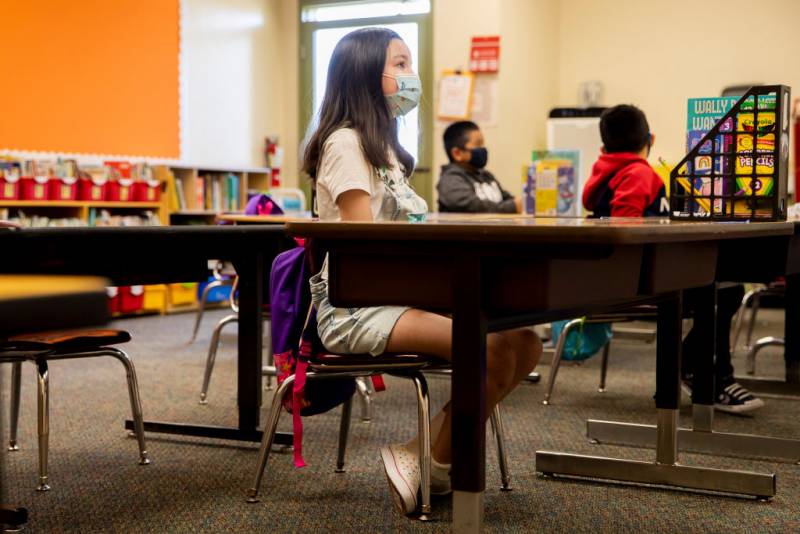“It is a step in the right direction in general, but I do have some concerns and it goes back to fear as a parent because we are still not out of it. I literally lost someone just last week that I know in my industry to COVID,” she said.
In Oakland Unified, parent Pecolia Manigo said when the state leaves it up to districts and local public health officials to decide what is safe, it puts the responsibility on families and on students to have to defend what they believe is safe for them.
“It also truly creates racial tensions, in the middle school, in the high schools,” said Manigo. “Because, you know, the students who are not feeling safe are not backed up and not reaffirmed by often staff who may have their own opinions shared or not. And so it’s an unfortunate situation. It’s unfortunate because it tells certain communities that even though you might have a right to feel safe, we’re not going to protect that right.”
Last week’s federal guidance shift on masks in schools came two weeks after several states controlled by Democrats, including Oregon, Massachusetts, Connecticut and New Jersey, already relaxed their school masking rules. On Sunday, New York’s governor said the state would lift its mask mandate on March 2. Several states have banned masks in schools.
National teachers organizations welcomed the CDC’s move away from universal masking. The American Federation of Teachers president Randi Weingarten cautioned, however, against bullying those who want to remain masked.
“Some parents, students and educators will still choose to wear masks, and there should be no stigma for those who do so. We have a duty to protect vulnerable populations and their right to attend school in person, and there should also be a limited remote option for those who require it,” she wrote in a statement.
In reaction to today’s rule change, the California Teachers Association President E. Toby Boyd said in a statement that reaction would be mixed.
“While some students are ready to immediately remove their masks, others remain very afraid. We urge local school districts to continue to work with educators and families and to act cautiously while prioritizing the safety of students, educators, and their families,” Boyd said.
In San Francisco, Cassondra Curiel, who heads the teachers union, also welcomed a way to ease mask requirements, stating that United Educators of San Francisco would work with the district and the city to “meet the needs of San Francisco students, families, staff, and educators. ”
In a UC Berkeley Institute of Governmental Studies poll out last week, of nearly 9,000 California registered voters, 65% approved of requiring masks in schools. In the Bay Area, 74% approved. However, opinions split radically along party lines, with 87% of Democrats approving and just 26% of Republicans.
And parents who continue to lack confidence that their children are safe from the virus while in school may balk at any lifting of mask restrictions.
According to the Berkeley IGS poll, Latino and Black parents expressed less confidence than white and Asian parents that their child was safe from the virus while in school.
Any divide over making masks optional could cause problems inside schools. CalMatters reported on tensions between groups of students at Nevada Joint Union High, south of Nevada City, last week over whether masks should be worn. CalMatters reported that so many of the district’s teachers called in sick in response to the district voting to lift its mask mandate, several schools were shut down.
In Oakland, Halima Watson, a first-year student at Oakland Technical High School, said that even if her district lifts the mask mandate, she’ll keep her mask on to keep others safe. “Because everyone reacts differently to COVID,” she said. “I have a friend who had it and she has had neurological problems and she’s had shaking with her body. I feel like it’s better to keep masking, but I feel like there are a lot of kids who don’t wear their masks properly so I don’t know if it will make much of a difference.”
Halima said there are already tensions inside her school about kids who don’t take the masking rule seriously. “There’s this kid who I sit next to in geometry who is very, like, whenever another kid has their mask off, he’s like, ‘Put your mask on.’ A lot of people would probably be very against it [lifting the mask mandate].”
Halima’s mom, Kim Watson, predicts if the district has a stricter set of rules than the CDC and the state, it is going to be difficult for teachers trying to insist kids wear their masks. “It could cause tension between peers and also between educators and students,” Watson said.
Some districts across California are already allowing students not to wear masks inside, defying state rules. Other local districts like Berkeley Unified have begun adjusting mask policies in consultation with local health officials and labor partners.
Beginning Feb. 28, BUSD students can go maskless outside. Superintendent Brent Stephens notified parents that the district will review today’s guidance from the state before announcing any planned indoor masking changes.
The Alameda County Office of Education also said it would be reviewing the state’s guidance before making any decisions.

